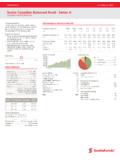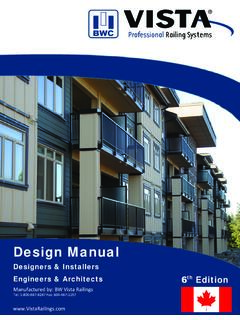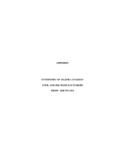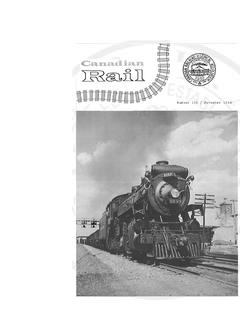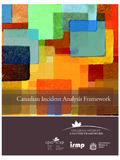Transcription of co
1 A SINGLE-FAMILY HOME OPERATES AS A CONCEPTUAL TESTING GROUND FOR A YOUNG FIRM INTENT ON EXPLORING SECTIONAL DYNAMICS ON COMPLEX SITES. PROJECT THE RIVER HOUSE, HUTIONVILLE, ONTARIO ARCHITECTS AGATHOM co TEXT GABRIEL FAIN PHOTOS M ICHAEL AWAD The River House is located in an unlikely place for contemporary architecture about an hour west of Toronto in the suburban community of Hut-tonville. Designed by husband -and - wife team Adam Thorn and KatjaAga Sachse Thorn of Agathom Co., this house for a couple and a child represents an important experiment and concep-tual testing ground for the young firm as they de-velop a body of work primarily focused on single-family dwellings. Although the River House is not without its flaws, it does establish a set of key themes which play a generative role in the firm's 46 CANADIAN ARCHITECT 09/10 ongoing work. These include the relationship be-tween landscape and building, the celebration of circulation, and the sculpting and layering of spaces in section.
2 Agathom is perhaps best known for Molly's Cabin- a well- publicized project that displays their understanding of how a building can be carefully calibrated to a difficult site. Similarly, the River House makes a strong gesture towards its naturally sloping and wooded terrain while being sensitive to an existing creek on the south-ern edge of the property. Even if the irregular wedge shape of the house was dictated largely by local zoning restrictions, the architects manage to take control of the design at key moments by framing the landscape and making it integral to the experience within. But as a whole, the design parti of the River seems to be highly driven by formal games. This inherent sense of playfulness does come at the expense of total conceptual clarity. Take the highly articulated front elevation with its second- floor setback. Here, the combination of wood, stucco, glass and concrete appear mis-placed and in direct contrast to the more contex-tual cedar-clad south elevation.
3 Equally confus-ing is the manner in which the low profile of the building is broken only once with an L- shaped concrete tower- oddly registering elements of a chimney that was removed in an early design stage. Perhaps more consequential in terms of inhabitation is the interior, which is defined largely through diagonal walls and stairs. This creates an interesting dynamic, yet is highly problematic as the geometry creates a number of strange corner conditions. The garage, for exam-ple, squeezes into the body of the house and abruptly protrudes into the study. On the second floor this results in an unusual entrance to the child's bedroom and an awkward triangular-shaped closet. For all of these formal weaknesses, however , there are many elements of the design that dem-onstrate an exceptional degree of rigour and thought. The manner in which the architects re -interpret the notion of movement through the domestic realm is clearly developed and repre-sents a recurring motif in their work.
4 The interi -or of the house is d efined as a series of complex circulation paths which both flow around diago-nal walls and shift in section to create a kind of artificial interior topography. The entrance is described by the architects as a "tornado"-an almost Piranesian double- height space where multiple paths converge and diverge. A brid~e on the second floor between the master bedroom and the child's bedroom completes the sequence and offers views back towards the entrance space below and out into the distant landscape. At the River House, the architects also begin to make a notable effort to enhance the inhabitant's sensorial experience of the house, again through the manipulation of the sectional plane. For ex-ample, windows do not simply function as open-ings, but rather as conceptual devices designed to create everchanging relationships between the viewer and the exterior ground plane. A key moment occurs in the sunken kitchen where the landscape curiously appears at eye level.
5 The ar-chitects seem to take advantage of this relation-ship by inserting a vertical piece of glass at the end of a long counter in order to provide glimps-OPPOSITE BEAUTIFULLY TEXTURED CONCRETE WALLS ARE ACHIEVED THROUGH THE USE OF ARTFULLY CONSTRUCTED PLYWOOD FORM WORK. CLOCKWISE FROM ABOVE THE BRIDGE OVER LOOKING THE DOUBLE HEIGHT STUDY IS ONE OF MANY FORMAL GESTURES INTENDED TO DEVELOP VISUAL CONNECTIONS WITHIN THE INTERIOR SPACES AND TO THE LANDSCAPE BEYOND; jATOBA PANELLING, STONE TILES AND SITE CAST CONCRETE DEFINE THE HOME'S INTERIOR MATERIAL PALETIE; THE CONFLATION OF ANGLED SURFACES COM PRISING THE DOUBLE HEIGHT ENTRY IS DES CRIBED BY THE ARCHITECTS AS A "TORNADO." es of those approaching the house. The exploration of the tactile realm also com-plements these formal strategies. One of the most exciting features of the design is a finely crafted jatoba staircase which rises to the second floor between two walls of exposed poured-in-place concrete- something very few residential 09/ 10 CANADIAN ARCHITECT 47 architects today would dare to try.
6 Recalling the material poetics of Brutalist architecture, the im-print of the plywood formwork used for pouring is clearly registered on the wall surfaces. The ex-perience of walking up this staircase, illuminated by a small opening to the north, seems to height-en the transition from the public realm to the private spaces of the house. It is important to note that all of these strate-gies are now being refined in Agathom' s current work. In a residential project at the base of an enormous hill in Toronto's High Park-referred to as the Reverse Ravine House-the architects have taken their sectional experiments in re -sponse to the terrain one step further by adding a secret passage to the basement on one level , the top of which doubles as a countertop on the half-level above. There is certainly no shortage of diagonal walls and stairs inAgathom's work. But in another house renovation underway in Peter-borough, the use of non- orthogonal geometry begins to work in service of their overall design parti.
7 Here, a new timber roof gently tilts away from the existing suburban house to create a dra-matic aperture that lets light in. It will be inter-esting to see how the firm will develop these earthwork/roofwork themes in later work-par-ticularly how they will be applied to typologies other than single- family dwellings. What is commendable in the River House is Agathom' s embrace of the contradictions and slippages which occur between what is perceived in reality and the logic that drives architectural intentions. The preoccupation with most young firms is the need to justify every single design move. Agathom seems to be fearless in this re -spect, and have demonstrated that they take enormous risks in all of their buildings. Adam and Katja represent a model of a young architec-tural practice that seeks to re-examine, study and refine key principles at play in each of their works, and in so doing, arrive at better design solutions in subsequent projects. CA Gabriel Fain is an intern architect at Kuwabara Payne McKenna Blumberg Architects.
8 He is currently completing a Master of Architecture degree at the Uni-versity of Toronto. RIGHT, TOP TO BOTTOM THE FRONT OF THE HOME REGISTERS A LOW PROFILE TO THE STREET, BUT IS PUNCTUATED BY AN L-SHAPED TOWER; WINDOWS IN THE SUNKEN KITCHEN CAP-TURE HORIZONTAL VIEWS OF THE EXTERIOR LANDSCAPE AT EYE LEVEL; TIGHT TRIANGULAR-SHAPED SPACES RESULT FROM THE ODD GEOMETRIES OF THE PLAN. 48 CANADIAN ARCHITECT 09/10 SECOND FLOOR \ \ \ \ \ \ \ \ GROUND FLOOR 1 ENTRANCE 2 KITCHEN 3 LIVING ROOM 4 DINING ROOM S STUDY 6 POWDER ROOM 7 VESTIBULE 9 12 \ \ 8 FURNACE ROOM 9 GARAGE 10 DRIVE 11 FRONT GARDEN 12 RAISED GARDEN 13 RAVINE 14 CREEK ..Jc 13 1 BEDROOM 2 lAUNDRY 3 BRIDGE 4 BATH S MASTER BATH 6 MASTER BEDROOM 7 CLOSET 8 SUN DECK 9 GRASS ROOF / / / / / / / / / / / 14 // / / / (!) 0 / / / / / 20' LEFT THE CEDAR-ClAD SOUTH ELEVATION IS AN ABRUPT CONTRAST TO THE CONCRETE AND STUCCO DEFINING THE NORTH ELEVATION OF THE HOME. SECTION C SECTION B SECTION A 1 ENTRY 2 STUDY 3 BRIDGE 4 GRASS ROOF S MASTER BEDROOM 6 MASTER BATH 7 DINING 8 KITCHEN CLIENT MICHELE PETIINEllA AND FAMILY 0 ARCHITECT TEAM KATJA AGA SACHSE !
9 HOM, ADAM !HOM STRUCTURAL HALCROW YOLLES MECHANICAL HYDRONIC HEATING INC LANDSCAPE/GRASS ROOF NATVIK DESIGN INC INTERIORS AGATHOM CO. MILLWORK GIBSON GREENWOOD CONTRACTOR DUFFY+ ASSOCIATES AREA 2,497 FF BUDGET WITHHELD COMPLETION SPRING 20 I 0 10' 09/10 CANADIAN ARCHITECT 49

